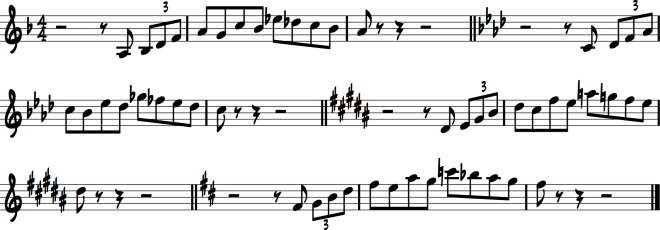We’re encouraged as jazz musicians to be able to improvise in every key. After all, you can’t play every single tune in F (or can you?) and even tunes in relatively common keys can throw a difficult set of ii Vs at you. Take Cherokee as an example, which after lulling the player into a sense of security in the Bb major ‘A’ section suddenly drops a ii V progression in B major into the mix in section ‘B’. It’s usually immediately obvious whether someone has really done their homework or is blagging that part of the chorus.
There are some issues to consider when thinking about how to achieve this on the trumpet.
First of all, not all notes on the trumpet are born equal. Seeing as the trumpet works by adding various lengths of pipe, essentially becoming 7 different trumpets to allow the player to play chromatically, some notes and keys are naturally more harmonically rich than others. Factor in also that some keys produce finger patterns that are especially awkward to play, meaning that some phrases are very difficult and others will simply never flow properly or sound as good in those keys. This means that mechanically transposing a phrase into every key might not always be the best option for a trumpet player.
With that being said, playing phrases in all of the keys is still a valuable exercise. It will help to train your ears, particularly if you transpose the phrases in certain patterns, as I will discuss below and it helps you to identify holes in your technique and improve them such as teaching your brain and your fingers where to access each phrase in each key, chord etc. Of course, if there is one key in which a phrase doesn’t sit properly and doesn’t seem like it ever will, it’s fine to alter it to something slightly different. Realistically, a very awkward finger pattern is unlikely to come out in your improvisation, so it’s be better to try and figure out something that works better, keeping as much of the intention of the original as possible.
Here are some suggestions for patterns that I think are particularly effective:
1. Dropping a semitone each time:
 This works nicely for short phrases and has a naturally musical sound. It’s common to encounter chords dropping by a semi tone when playing tunes as well (such as descending ii Vs or dominant chords), so it’s good to have this at your disposal.
This works nicely for short phrases and has a naturally musical sound. It’s common to encounter chords dropping by a semi tone when playing tunes as well (such as descending ii Vs or dominant chords), so it’s good to have this at your disposal.
2. Ascending or descending minor 3rds:
Chords which are a minor 3rd or tri-tone apart are closely related, particularly dominant chords such as in tri-tone substitutions and back door ii Vs.

The last is an example of somewhere you might modify a line to make it work better, if it’s too awkward to play in that register. For example, you could keep the same melodic intention but make it easier to play like this:

Transposing this way can help you to organise information in your head into related keys. Any group of pitches can only be transposed up or down a minor 3rd three times (making four in total) before you return to the same set of notes again. Therefore, in order to play all twelve keys you will have to play three groups of four. In the example above the keys are F, Ab, B, D. The other two groups will be F#, A, C, Eb and G, Bb, C#, E.
3. Circle of fourths

This one is probably obvious, but since the circle of fourths is such an important harmonic relationship to jazz and for that matter, all western music, it’s makes sense to practice like this.


Thanks for checking out my site, I’ve enjoyed checking out yours too – looking forward to Lee Morgan month, just been getting into his stuff this week. We have Mike Stern coming to visit here in February so I’m going to doing some stuff to tie in with that 🙂
Best regards,
Ciaran
LikeLike
Nice one man. I’m working on some Lee Morgan transcriptions, reviews and tutorials for next month. One of my favourite trumpet players.
LikeLike